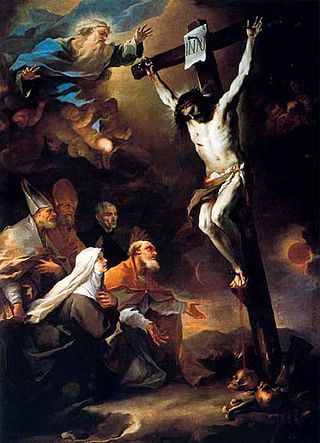
San Gennaro extra Moenia is a church in Naples, Italy. It is located in the Rione Sanita on the large road that leads up to the Capodimonte museum and is an example of so-called paleo-Christian architecture in the city.

San Gennaro dei Poveri is a former monastery and church complex, later converted into a hospital for indigent located on Via San Gennaro dei Poveri #25 in the Rione Sanità, of the city of Naples, Italy. The elongated complex rises towards Capodimonte, lying just south of the domed Basilica dell'Incoronata Madre del Buon Consiglio.

The Catacombs of San Gennaro are underground paleo-Christian burial and worship sites in Naples, Italy, carved out of tuff, a porous stone. They are situated in the northern part of the city, on the slope leading up to Capodimonte, consisting of two levels, San Gennaro Superiore, and San Gennaro Inferiore. The catacombs lie under the Rione Sanità neighborhood of Naples, sometimes called the "Valley of the Dead". The site is now easily identified by the large church of Madre del Buon Consiglio.

Aspren or Asprenas was a 1st-century Christian saint and venerated as the first Bishop of Naples.
Saint Gaudiosus of Naples or Gaudiosus the African was a bishop of Abitina in Africa Province during the 5th century AD Abitina was a village near Carthage in present-day western Tunisia.

Saint Severus was a bishop of Naples during the 4th and 5th centuries. He is considered the twelfth bishop of Naples, succeeding Maximus. His episcopate ran from February 363 to April 29, 409, the traditional date of his death. Maximus is actually considered the 10th bishop by the Catholic Church; between the episcopates of Maximus and Severus was the episcopate of Zosimus, who was Arian and thus considered heretical by the Catholic Church.

University of Naples "L'Orientale" is a university located in Naples, Italy. Founded in 1732 by Matteo Ripa, it is organized in four Faculties. The oldest school of Sinology and Oriental Studies of the European continent is the main university in Italy specializing in the study of non-European languages and cultures, with research and studies agreements with universities all over the world. It is one of the top universities in the world regarding Asian cultures and languages.

Christianity and religion in general has always been an important part of the social and cultural life of Naples. It is the seat of the Archdiocese of Naples, and the Catholic faith is highly important to the people of Naples and there are hundreds of historic churches in the city. The Cathedral of Naples is the most important place of worship in the city, each year on September 19 it hosts the Miracle of Saint Januarius, the city's patron saint. In the miracle which thousands of Neapolitans flock to witness, the dried blood of Januarius is said to turn to liquid when brought close to relics said to be of his body: this is one of the most important traditions for Neapolitans.

The districts of Naples are the sectors that, within the city, are identified by particular geographical and topographical, functional and historical features.

Rione Sanità is a neighbourhood in Naples, part of the Stella quarter. It is located north of Naples' historical centre, adjacent to the Capodimonte hill.

The Church of the Immacolata e San Vincenzo and its adjacent convent, are religious buildings in piazzetta San Vincenzo of the Rione Sanità of Naples, Italy.

The Basilica of Santa Maria della Sanità is a basilica church located over the Catacombs of San Gaudioso, on a Piazza near where Via Sanità meets Via Teresa degli Scalzi, in the Rione of the Sanità, in Naples, Italy. The church is also called San Vincenzo or San Vincenzo della Sanità, due to the cult of an icon of San Vincenzo Ferrer, also called locally O' Monacone.

Santa Maria Regina Coeli is a Roman Catholic church in central Naples, Italy.

Santa Maria della Sapienza is a Roman Catholic church, located on Via Costantinopoli in central Naples, Italy.

The Basilica of San Giovanni Maggiore is a church in Largo San Giovanni Maggiore in central Naples, Italy.

Michelangelo Naccherino was an Italian sculptor and architect, active mainly in the Kingdom of Naples, Italy.
Santolo Cirillo was an Italian painter, engraver, and stucco artist, active in Naples. He was born in Grumo Nevano, a town near Naples. He contributed frescoes and paintings the Cathedral of San Gennaro, the Basilica of Santa Restituta, and Santa Donna Regina Nuova in Naples. He also painted for the Basilica di San Tammaro in his home town of Grumo Nevano. He frescoed in 1733 a Miracle of San Domenico and a San Pio in Prayer for Santa Caterina a Formiello, painted in the style of Paolo de Matteis.

Santa Maria dei Vergini is a church in central Naples, Italy, in the Rione of the Sanità.
The chapel of Santa Maria a Sicola is a small Roman Catholic medieval chapel, off Via Giudecca Vecchia, in the neighborhood of Forcella, in the Quartieri Pendino of Naples, Italy.
Naples (Italy) and its immediate surroundings preserve an archaeological heritage of inestimable value and among the best in the world. For example, the archaeological park of the Phlegraean Fields is directly connected to the centre of Naples through the Cumana railway, and the nearby sites of Pompeii, Herculaneum, Stabiae and Oplontis are among the World Heritage Sites of UNESCO.

























